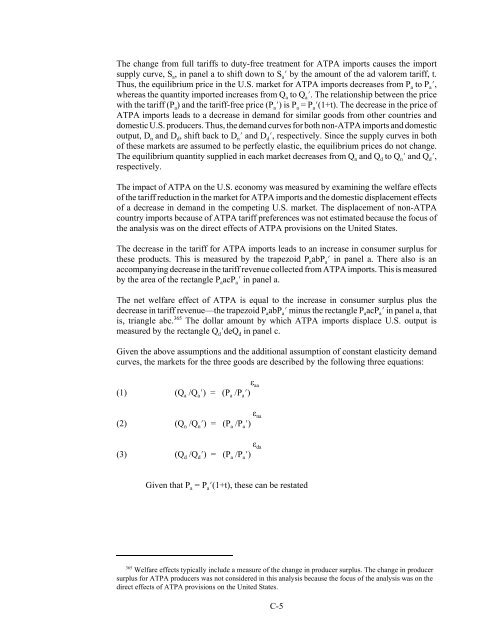The Impact of the Andean Trade Preference Act Twelfth ... - USITC
The Impact of the Andean Trade Preference Act Twelfth ... - USITC
The Impact of the Andean Trade Preference Act Twelfth ... - USITC
- No tags were found...
Create successful ePaper yourself
Turn your PDF publications into a flip-book with our unique Google optimized e-Paper software.
<strong>The</strong> change from full tariffs to duty-free treatment for ATPA imports causes <strong>the</strong> importsupply curve, S a , in panel a to shift down to S a N by <strong>the</strong> amount <strong>of</strong> <strong>the</strong> ad valorem tariff, t.Thus, <strong>the</strong> equilibrium price in <strong>the</strong> U.S. market for ATPA imports decreases from P a to P a N,whereas <strong>the</strong> quantity imported increases from Q a to Q a N. <strong>The</strong> relationship between <strong>the</strong> pricewith <strong>the</strong> tariff (P a ) and <strong>the</strong> tariff-free price (P a N) is P a = P a N(1+t). <strong>The</strong> decrease in <strong>the</strong> price <strong>of</strong>ATPA imports leads to a decrease in demand for similar goods from o<strong>the</strong>r countries anddomestic U.S. producers. Thus, <strong>the</strong> demand curves for both non-ATPA imports and domesticoutput, D n and D d , shift back to D n N and D d N, respectively. Since <strong>the</strong> supply curves in both<strong>of</strong> <strong>the</strong>se markets are assumed to be perfectly elastic, <strong>the</strong> equilibrium prices do not change.<strong>The</strong> equilibrium quantity supplied in each market decreases from Q n and Q d to Q n N and Q d N,respectively.<strong>The</strong> impact <strong>of</strong> ATPA on <strong>the</strong> U.S. economy was measured by examining <strong>the</strong> welfare effects<strong>of</strong> <strong>the</strong> tariff reduction in <strong>the</strong> market for ATPA imports and <strong>the</strong> domestic displacement effects<strong>of</strong> a decrease in demand in <strong>the</strong> competing U.S. market. <strong>The</strong> displacement <strong>of</strong> non-ATPAcountry imports because <strong>of</strong> ATPA tariff preferences was not estimated because <strong>the</strong> focus <strong>of</strong><strong>the</strong> analysis was on <strong>the</strong> direct effects <strong>of</strong> ATPA provisions on <strong>the</strong> United States.<strong>The</strong> decrease in <strong>the</strong> tariff for ATPA imports leads to an increase in consumer surplus for<strong>the</strong>se products. This is measured by <strong>the</strong> trapezoid P a abP a N in panel a. <strong>The</strong>re also is anaccompanying decrease in <strong>the</strong> tariff revenue collected from ATPA imports. This is measuredby <strong>the</strong> area <strong>of</strong> <strong>the</strong> rectangle P a acP a N in panel a.<strong>The</strong> net welfare effect <strong>of</strong> ATPA is equal to <strong>the</strong> increase in consumer surplus plus <strong>the</strong>decrease in tariff revenue—<strong>the</strong> trapezoid P a abP a N minus <strong>the</strong> rectangle P a acP a N in panel a, thatis, triangle abc. 365 <strong>The</strong> dollar amount by which ATPA imports displace U.S. output ismeasured by <strong>the</strong> rectangle Q d NdeQ d in panel c.Given <strong>the</strong> above assumptions and <strong>the</strong> additional assumption <strong>of</strong> constant elasticity demandcurves, <strong>the</strong> markets for <strong>the</strong> three goods are described by <strong>the</strong> following three equations:ε aa(1) (Q a /Q a N) = (P a /P a N)ε na(2) (Q n /Q n N) = (P a /P a N)ε da(3) (Q d /Q d N) = (P a /P a N)Given that P a = P a N(1+t), <strong>the</strong>se can be restated365Welfare effects typically include a measure <strong>of</strong> <strong>the</strong> change in producer surplus. <strong>The</strong> change in producersurplus for ATPA producers was not considered in this analysis because <strong>the</strong> focus <strong>of</strong> <strong>the</strong> analysis was on <strong>the</strong>direct effects <strong>of</strong> ATPA provisions on <strong>the</strong> United States.C-5
















